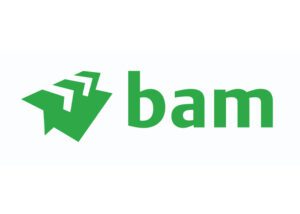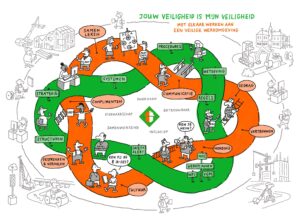The Safety Culture Ladder (SCL) has successfully taken root at BAM Nederland. According to Hans Wentink, the various aspects of the SCL philosophy form one of the two currents through which the company wants to provide a safe working environment.
Wentink is co-director of QHSE at construction company BAM Nederland. He is responsible for two of the four segments the company consists of: Bouw & Techniek (Construction & Technology) and BAM Specials. 'My focus within our management team is on safety, in particular the cultural aspect of safety.'
Risk perception
The SCL has been used within the segments that fall under Wentink's responsibility since 2019. 'The main reason for this is that there were still relatively many accidents and safety needed to take greater priority on the agenda. Procedure-wise, everything was in order; for example, there were H&S plans and a sanctions and rewards policy. What we saw, however, was that these matters didn’t receive sufficient attention in practice and that employees’ risk perception was not consistent at all. What one employee might find risky might be seen as safe by someone else. If you wish to raise the safety level, there must be dialogue between the persons involved.'
Safer
In Wentink's opinion, discussing safety has made BAM Nederland a safer company. 'Our primary focus used to be on following the rules, for example when it came to wearing PPE. If you were wearing your hard hat, fine, if you weren't wearing it, you'd be punished. The SCL helps start up the discussion and encourages the parties to jointly consider why someone might not be wearing a hard hat, even though it’s mandatory. This raises more awareness on the part of employees. We’re not doing this to make things hard on people or because it looks good, but because, at the end of the day, we want everyone to get back home to their families safe and sound.' Wentink has another example. 'When doing a project for a local authority that involves hoisting work at a child daycare facility, we discuss with the local authority whether it’s safe for the children to play outside during the project. This creates more safety awareness on the part of the clients during the tender stage.'
Two currents
The SCL is one of the two currents that come together at BAM and that together are intended to provide a safe working environment. The green current consists of 'hard', measurable matters such as rules, procedures and strategy. The orange current consists of 'softer' aspects such as attitude and behaviour, communication and confidence. These are less easy to measure. 'VCA or toolboxes and the like belong to the first current, but precisely how you set this up and approach it, is part of the second current', is how Wentink explains BAM's perspective. 'That’s where SCL comes into the picture. Together those two currents raise safety to a higher level.' Wentink has seen this reflected in reality. The introduction of the SCL has seen an increase in the willingness to report. The topic has become more relevant and is discussed more openly. This is a positive effect.'
A broader view
BAM is trying to get the SCL philosophy take root among customers and clients. 'Sometimes this results in friction with financial aspects of projects. We believe it’s important to draw attention to this and to start up a serious discussion.'
Tips
Wentink recalls that initially the introduction of the SCL met with some resistance at BAM. 'The first reaction was 'what, not another certificate?!'. We’ve had to engage in a great deal of lobbying to show everyone within the organisation how useful the SLC is and to point out the importance of the cultural aspect of safety, but it’s now clear that it works and it receives a lot of support.' In addition to removing any resistance, Wentink gives the tip of looking for the right certification body that fits in with the company. 'This will help an audit go more smoothly.'

